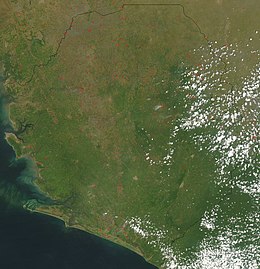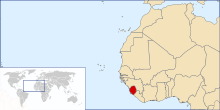Geography of Sierra Leone
 | |
| Continent | Africa |
|---|---|
| Region | WesternAfrica |
| Coordinates | 08°30′00″N12°06′00″W/ 8.50000°N 12.10000°W |
| Area | |
| • Total | 71,740 km2(27,700 sq mi) |
| • Land | 99.8% |
| • Water | 0.2% |
| Coastline | 402[1]km (250 mi) |
| Highest point | Mount Bintumani1,948 meters (6,391 ft)[1] |
| Lowest point | Atlantic Ocean 0m |
| Longest river | Rokel River400 km (250 mi)[2] |
| Largest lake | Lake Sonfon8.2 km2(3.2 sq mi)[3] |
| Climate | tropical |
| Terrain | coastal belt ofmangrove swamps,wooded hill country, an uplandplateau,mountains in the east[1] |
| Natural resources | mineral deposits (diamonds,titaniumore,bauxite,iron ore, gold,chromite)[1] |
| Natural hazards | dry, sand-ladenHarmattanwinds blow from theSahara(December to February); sandstorms, dust storms[1] |
| Environmental issues | rapid population growth;deforestationfrom increased cattle grazing and agriculture,land degradationand flooding;biodiversity loss;air and water pollution; overfishing[1] |
Sierra Leoneis a country inWest Africawith aNorth Atlantic Oceancoastlineto the west. It lies on theAfrican Plate.The country's maingeographicalfeatures include wooded hill country, an uplandplateau,and mountains in the east. The highest peak isMount Bintumani,which is 1,948 meters (6,391 ft) above sea level. The coastline has a belt ofmangrove swamps.Freetown, the nation's capital city, has one of the world's largest natural harbours.[4]TheRokel Riveris the largest river in Sierra Leone. It is 400 kilometres (250 mi) long and has a basin with a total area of 10,622 square kilometres (4,101 sq mi).
Sierra Leone is located at approximately8°30′N12°06′W/ 8.5°N 12.1°W,between the7thand10th parallelsnorth of theequator.It is bordered byGuineato the north and northeast, andLiberiato the south and southeast.[5]The country has a total area of 71,740 km2(27,699 sq mi), divided into a land area of 71,620 km2(27,653 sq mi) and water of 120 km2(46 sq mi).[1]
Physical geography
[edit]
Sierra Leone is located on the west coast of Africa, between the7thand10th parallelsnorth of theequator.Sierra Leone is bordered byGuineato the north and northeast,Liberiato the south and southeast, and the Atlantic Ocean to the west.[5]The country has a total area of 71,740 km2(27,699 sq mi), divided into a land area of 71,620 km2(27,653 sq mi) and water of 120 km2(46 sq mi).[1]
Sierra Leone has four distinct geographical regions: coastalGuinean mangroves,the wooded hill country, an uplandplateau,and the eastern mountains. Eastern Sierra Leone is an interior region of large plateaus interspersed with high mountains, whereMount Bintumanirises to 1,948 meters (6,391 ft).[5]
Geology
[edit]Sierra Leone can be split into three geological areas, in the east is part of theWest African craton,the western area consists of the Rokelides, anorogenicbelt, and a 20- to 30-km coastal strip ofsediments.[6]
Extreme points
[edit]This is a list of the extreme points of Sierra Leone, the points that are farther north, south, east or west than any other location.
- Northernmost point – the northern section of the border with Guinea,Northern Province*
- Easternmost point – thetripointwith Guinea andLiberia,Eastern Province
- Southernmost point – unnamedpeninsulasouth of the town of Mano Salija at the mouth of theMano River,Southern Province
- Westernmost point – the point at which the border with Guinea enters the Atlantic Ocean,North West Province
- *Note: Sierra Leone does not have a northernmost point, the border being formed here by10th parallel north
Climate
[edit]
Theclimateistropical;although it could be classified as atropical monsoon climate,it could also be described as a climate that is transitional between a continually wettropical rainforest climateand atropical savanna climate.[7]
There are two seasons; dry season (November – May) and rainy season (June – October).
December to January are the coolest months of the year, although temperatures can still exceed 40 °C or 104 °F, lower to moderate humidity makes the heat around this time of the year more tolerable. Unlike March and April, the months that it gets hot and humid with temperatures around 33 to 36 °C or 91 to 97 °F and a solid 50% humidity, making the heat index higher than the actual temperature. The average sea temperature is 30 °C or 86 °F.[1][8][9]
Average rainfall is highest at the coast, 3,000 to 5,000 millimetres or 120 to 200 inches per year; moving inland this decreases and at the eastern border of the country, the average rainfall is 2,000 to 2,500 millimetres or 80 to 100 inches.[10]
| Climate data for Freetown, Sierra Leone (1961-1990, extremes 1947-1990) | |||||||||||||
|---|---|---|---|---|---|---|---|---|---|---|---|---|---|
| Month | Jan | Feb | Mar | Apr | May | Jun | Jul | Aug | Sep | Oct | Nov | Dec | Year |
| Record high °C (°F) | 36.0 (96.8) |
38.0 (100.4) |
38.0 (100.4) |
38.5 (101.3) |
35.0 (95.0) |
35.0 (95.0) |
33.0 (91.4) |
32.0 (89.6) |
31.0 (87.8) |
35.0 (95.0) |
36.5 (97.7) |
33.5 (92.3) |
38.5 (101.3) |
| Mean daily maximum °C (°F) | 29.9 (85.8) |
30.3 (86.5) |
30.9 (87.6) |
31.2 (88.2) |
30.9 (87.6) |
30.1 (86.2) |
28.7 (83.7) |
28.4 (83.1) |
29.0 (84.2) |
29.9 (85.8) |
30.1 (86.2) |
29.7 (85.5) |
29.9 (85.9) |
| Daily mean °C (°F) | 27.3 (81.1) |
27.6 (81.7) |
28.1 (82.6) |
28.5 (83.3) |
28.3 (82.9) |
27.4 (81.3) |
26.3 (79.3) |
25.9 (78.6) |
26.4 (79.5) |
27.1 (80.8) |
27.7 (81.9) |
27.5 (81.5) |
27.3 (81.2) |
| Mean daily minimum °C (°F) | 23.8 (74.8) |
24.0 (75.2) |
24.4 (75.9) |
24.8 (76.6) |
24.4 (75.9) |
23.6 (74.5) |
23.1 (73.6) |
23.0 (73.4) |
23.1 (73.6) |
23.4 (74.1) |
24.0 (75.2) |
24.1 (75.4) |
23.8 (74.9) |
| Record low °C (°F) | 15.0 (59.0) |
17.8 (64.0) |
19.4 (66.9) |
20.0 (68.0) |
20.6 (69.1) |
20.0 (68.0) |
19.4 (66.9) |
19.4 (66.9) |
20.0 (68.0) |
19.4 (66.9) |
20.0 (68.0) |
15.6 (60.1) |
15.0 (59.0) |
| Average rainfall mm (inches) | 8.0 (0.31) |
6.0 (0.24) |
28.0 (1.10) |
68.0 (2.68) |
214.0 (8.43) |
522.0 (20.55) |
1,190 (46.85) |
1,078 (42.44) |
800.0 (31.50) |
333.0 (13.11) |
148.0 (5.83) |
38.0 (1.50) |
4,433 (174.54) |
| Average rainy days | 0 | 0 | 1 | 4 | 15 | 22 | 27 | 27 | 24 | 21 | 9 | 2 | 152 |
| Averagerelative humidity(%) | 66 | 67 | 67 | 68 | 73 | 76 | 81 | 82 | 80 | 78 | 76 | 69 | 74 |
| Mean monthlysunshine hours | 226.3 | 215.6 | 232.5 | 207.0 | 189.1 | 153.0 | 102.3 | 86.8 | 126.0 | 186.0 | 198.0 | 161.2 | 2,083.8 |
| Source 1: NOAA,[11][12]Deutscher Wetterdienst(extremes),[13] | |||||||||||||
| Source 2: Worldwide Bioclimatic Classification System[14] | |||||||||||||
Environment issues
[edit]
Rapid population growth in Sierra Leone has put pressure upon the natural environment. Environmental problems include theoverharvestingof timber, the expansion of cattle grazing andslash and burnagriculture have resulted indeforestationand soil exhaustion, andoverfishing.
Sierra Leone is party to several environmental agreements:[1]
- Biodiversity(Convention on Biological Diversity)
- Climate Change(United Nations Framework Convention on Climate Change)
- Desertification(United Nations Convention to Combat Desertification)
- Endangered Species(CITES)
- Law of the Sea(UNCLOS or LOS)
- Marine Life Conservation(Convention on Fishing and Conservation of Living Resources of the High Seas)
- Nuclear Test Ban(CTBT)
- Ramsar Convention(Wetlands)
Signed, but not ratified:
- Environmental Modification(ENMOD)
General information
[edit]
Geographic coordinates:8°30′N11°30′W/ 8.500°N 11.500°W
- Area
-
- Total: 72,300 km²
- country rank in the world:117th
- Land: 72,180 km²
- Water: 120 km²
- Total: 72,300 km²
- Area comparative
-
- Australia comparative: slightly larger thanTasmania
- Canada comparative: approximately the size ofNew Brunswick
- United Kingdom comparative: slightly smaller thanScotland
- United States comparative: approximately1/7larger thanWest Virginia
- EUcomparative: slightly smaller thanIreland
- Land boundaries
-
- total: 1,093 km
- border countries: Guinea 794 km, Liberia 299 km
- Coastline
- 402 km
- Maritime claims
-
- territorial sea: 200nmi(370.4 km; 230.2 mi).
- contiguous zone: 24 nmi (44.4 km; 27.6 mi).
- exclusive economic zone: 200 nmi (370.4 km; 230.2 mi).
- continental shelf: 200 m depth or to the depth of exploitation.
- Climate
- tropical monsoon;hot, humid; summer rainy season (May to December); winter dry season (December to April)
- Terrain
- coastal belt ofmangroveswamps, wooded hill country, upland plateau, mountains in east
- Elevation extremes
-
- lowest point:Atlantic Ocean0 m
- highest point:Loma Mansa(Bintimani) 1,948 m
- Land use
-
- arable land: 24.4%
- permanent crops: 2.3%
- permanent pasture: 30.5%
- forest: 37.5%
- other: 6.3% (2011)
- Irrigated land
- 300 km2;(2012)
- Total renewable water resources
- 160 km3;(2011)
- Natural hazards
- dry, sand-ladenharmattanwinds blow from theSahara(December to February);sandstorms,dust storms
See also
[edit]References
[edit]- ^abcdefghij"Sierra Leone".World Factbook.CIA.gov.Retrieved14 November2021.
- ^"Rokel River".Britannia.Retrieved14 November2021.
- ^"Lake Sonfon – Sierra Leone".Living Lakes.Global Nature Fund.Retrieved14 November2021.
- ^"Sierra Leone".Britannia.Retrieved14 November2021.
- ^abcLeVert 2007,p. 7.
- ^Schlüter & Trauth 2008,p. 220.
- ^Gabler et al. 2008,p. 238.
- ^Blinker 2006,p. 12.
- ^LeVert 2007,p. 8.
- ^Hughes & Hughes 1992,p. 435.
- ^"Freetown Climate Normals 1961–1990".National Oceanic and Atmospheric Administration.RetrievedFebruary 7,2016.
- ^"Climatological Information for Freetown, Sierra Leone".Hong Kong Observatory.Archived fromthe originalon November 24, 2002.RetrievedAugust 25,2016.
- ^ "Klimatafel von Freetown-Lunghi (Flugh.) / Sierra Leone"(PDF).Baseline climate means (1961–1990) from stations all over the world(in German). Deutscher Wetterdienst.RetrievedFebruary 7,2016.
- ^"Sierra Leone — Freetown".Worldwide Bioclimatic Classification System.RetrievedJuly 24,2021.
Sources
[edit]- Blinker, Linda (2006)."Country Environment Profile (CEP) Sierra Leone"(PDF).Freetown: Consortium Parsons Brinckerhoff. Archived fromthe original(PDF)on 1 October 2008.Retrieved25 September2008.
{{cite journal}}:Cite journal requires|journal=(help) - Gabler, Robert E.; Petersen, James F.; Trapasso, L. Michael; Sack, Dorothy (2008).Physical Geography.Cengage Learning.ISBN978-0-495-55506-3.
- Hughes, R. H; Hughes, J. S. (1992).A Directory of African Wetlands.IUCN.ISBN978-2-88032-949-5.
- LeVert, Suzanne (2007).Cultures of the World: Sierra Leone.Marshall Cavendish.ISBN978-0-7614-2334-8.
- Schlüter, Thomas; Trauth, Martin H. (2008).Geological Atlas of Africa: with notes on stratigraphy, tectonics, economic geology, geohazards, geosites and geoscientific education of each country.Springer.ISBN978-3-540-76324-6.

